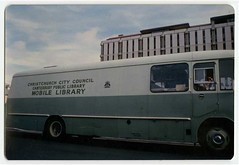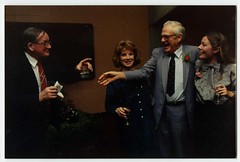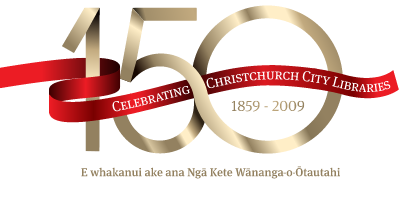John Edwin Denys Stringleman (1921-1995)
 When John Stringleman retired a long ode was composed in his honour by Margaret Mahy and performed by the “Stringlesingers”. One of the verses went:
When John Stringleman retired a long ode was composed in his honour by Margaret Mahy and performed by the “Stringlesingers”. One of the verses went:
The people said as he began,
“He’s got a lot in common with the great Tarzan”,
A library leader, lithe and lean,
Needs half a dozen branches to cavort between,
“I have a vision” murmered he,
“A bit of better branching on the library tree”,
And what he planned has come to be…,
We go bobbing through the branches of the library.
This reflects a significant area where John Stringleman made an impact during his time of leadership – the development of the library into a network of professionally staffed libraries serving suburban Christchurch. During his tenure (1968-1986) he also oversaw the move to the new Central Library, automation of circulation and took a leading role in library professional organisations in New Zealand and overseas.
Early career
John Stringleman joined Canterbury Public Library in 1938 as a student assistant. Prior to that he went to Christchurch Boys’ High School and had two years at Canterbury University College. His first job was “a source of money while he was a student at the University of Canterbury, studying arts”. He never finished the degree, as World War II intervened.
He joined the Navy and became a pilot in the Fleet Air Arm where he served from 1941 to 1946. While in England he received a rehabilitation bursary, studying mainly at the Manchester Public Library. He was in England he was offered a position as assistant librarian in Christchurch and returned to New Zealand in June 1947. He studied at the New Zealand Library School being awarded the Certificate in November 1947.
In 1948, when the Christchurch City Council took over the library from the university, he became deputy city librarian, serving under first Ernest Bell and then Ron O’Reilly. When O’Reilly spent two years in Nigeria in 1964-65, John Stringleman was acting City Librarian and he took over when Ron O’Reilly moved to the National Library School in 1968.
The City Librarian years
In an interview in the Christchurch Star, Thursday December 12, 1968 he highlighted the “crying need” for a new building and was soon heavily involved in the search for a suitable site. He was quoted in The Press (13 March 1971): “the City Librarian (Mr J.E.D Stringleman has argued plausibly that a modern library must be sited, like a department store, to give the maximum service to the greatest number of people.”
In December 1972, returning from a visit to Britain, Canada and Nigeria to study metropolitan libraries, he commented: “overseas the importance of strategic siting of public libraries was demonstrated and emphasised”.
A site on Worcester Street was first proposed before in 1974 the council settling on the site formerly occupied by the Pioneer Sports Club on the corner of Gloucester Street and Oxford Terrace.
The Star interview of 1968 also quoted him as saying there was a need for more financial assistance for Christchurch’s community run suburban library service.
“He intended to suggest to the council that trained librarians should work with community run staff in the suburban libraries and also that more of these libraries should be built in areas with no local service such as Shirley, Bryndwr and Aranui. It was also hoped that a mobile library service should be established in Christchurch”
 And indeed the first mobile library hit the road in 1970, Spreydon Library became the first purpose-built, professionally-staffed library in the city network in 1971, followed by New Brighton in 1974, Papanui in 1978, Shirley in 1981 and at the time of his retirement in 1986, Linwood Library was in the pipeline.
And indeed the first mobile library hit the road in 1970, Spreydon Library became the first purpose-built, professionally-staffed library in the city network in 1971, followed by New Brighton in 1974, Papanui in 1978, Shirley in 1981 and at the time of his retirement in 1986, Linwood Library was in the pipeline.
Being a male librarian in a female-dominated profession was not always easy and he once quoted the example of one county clerk who had letters addressed to him as “Dear Madam” for 10 years. It was enough to make a man change his name to “Stringleperson” he said.
Automation
During John Stringleman’s years at Canterbury Public Library significant developments were made in the automation of library processes. A punched-card system, using Powers-Samas machinery, was introduced on 7 August, 1958. The library was the first in New Zealand to have a mechanised circulation system.
Eventually the Powers-Samas technology became outdated and John Stringleman was heavily involved in the planning to acquire an English automated circulation system called ALS (Automated Library System). The system began operation on 29 January 1975 and was another significant achievement for the library becoming the first in New Zealand to have an automated circulation system.
By the early 1980s the system was failing and he set up a project team to look for another that would enable it to automate as many of its functions as possible. Eventually in October 1986 an agreement was made with DRA and its New Zealand agent, Datacom Systems, to install ATLAS (A Total Library Automation System), later called DRS. The system became operational in mid-November 1986.
Controversy and cartoons
Sometimes the role of City Librarian could be controversial as when the library was closed “not just on New Zealand Day but on the Saturday” He was pilloried by humorist A.K. Grant as Brigadier Librarian Swinglesinger, operating “deep in the underground bunker of Canterbury Public Library Operations Control”
John Stringleman was always looking ahead to the wider picture. In an interview at the time of becoming President of NZLA (with Bruce Scott in the Christchurch Star, Saturday March 1, 1975) he said he was “an advocate of library amalgamation and believes that the Christchurch urban area should have one central library with branches in some suburbs”.
Contributions to professional organisations
Over the years John Stringleman was very active in library professional associations. He was awarded an associateship of the New Zealand Library Association in 1956 and a fellowship of the Association in 1975. From 1975 to 1976 he was President of the Association.
In 1971 he became New Zealand’s first representative on the Commonwealth Library Association (COMLA) and continued his involvement over the years, eventually becoming president. His term ended in 1986 but he continued as a member of the executive for another three years. In May 1971 he was selected to represent the New Zealand Library Association at three library conferences in Britain in August and September.
He went to Liverpool for a UNESCO seminar, then was the New Zealand delegate to the annual conference of the International Federation of Library Associations, also in Liverpool. He then went to London to attend a conference sponsored by the Commonwealth Foundation to explore the possibility of setting up a Commonwealth association of librarianship. After the conference he studied new library buildings and techniques on behalf of the city council.
Reporting back he observed that in Britain “mistakes had been made with some new libraries which had been too rigidly planned. He said that to give the lending and reference sections more flexibility he would like to see a building which was not made up of too many rooms”.
Retirement
 1985 he received the Queen’s Service Order (QSO). The citation said he “Pioneered the use of automated circulation control system and showed leadership in the planning of the new central library building.”
1985 he received the Queen’s Service Order (QSO). The citation said he “Pioneered the use of automated circulation control system and showed leadership in the planning of the new central library building.”
An interview in The Star entitled “Life’s an Open book for him” captures the flavour of the man and his career.
“He’s enjoyed it – a born librarian, he reckons – and would do every bit again, given the chance”
“One of the most important things I stressed was the need for a central city site” he says. The river he believed had acted as a psychological barrier to many people who had never visited the Cambridge Terrace building. Everyone agreed it was high time for a new building but the central city site took some talking. Many saw the library as a monument, standing alone, distanced from the city. Not Mr Stringleman. “It’s akin to retail activity – people come to town to go shopping and to go to the library” he says.”
“The public areas were open plan people could see the library laid out before them. Straight forward, no interior wall and generous views both sides of the glass” It was a shedding of the fusty, claustrophobic “quiet please’ library Mr Stringleman says.
“He has fond memories of the old library though and is thankful it was spared demolition. An old sign warning borrowers that any transgressions will bring prosecution and an ornate ceiling ventilation fan are mementoes of those decades”.
Still he left without a backward glance, he says, such was the nightmarish improvisation necessary to keep the building operating. His mettle tested from his share of blustering borrowers over the years, Mr Stringleman reckons it could be interesting when he swaps sides of the desks soon. He knows the ropes. Storm in. Go to the top. They come in like a train, he says. But he’s always been able to settle the problem amicably. It never came to blows. Went out like lambs. He might just give it a go himself one day…”
References
- This is your life : John Stringleman / [compiled by New Zealand Collection, Canterbury Public Library] Reference 52 ANZ Archives
- Interview “Life’s an open book for him” with Sandra Stewart, The Star, 18 July, 1986 p20



